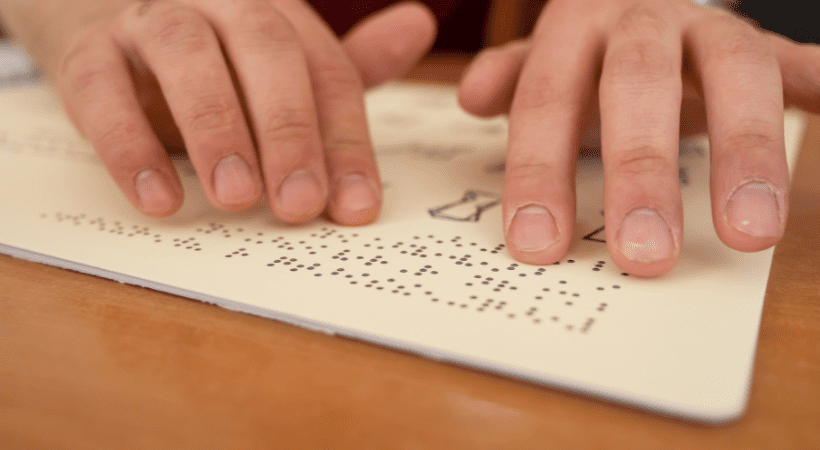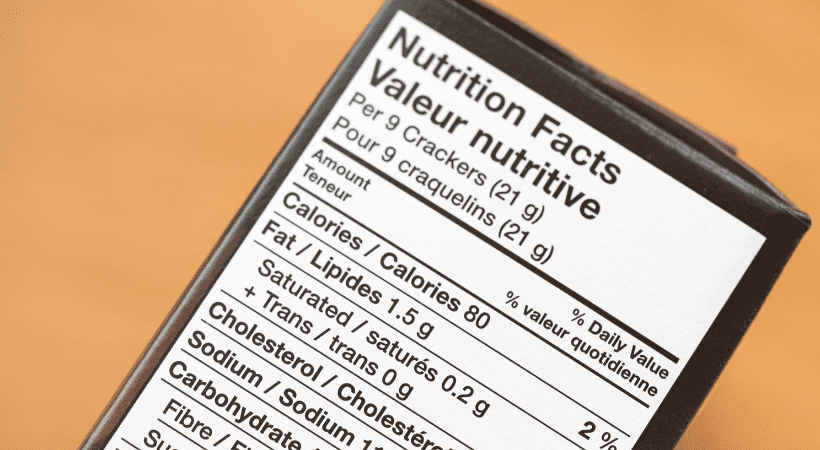Inclusive Labels for the Visually Impaired: Challenges & Solutions for the Food Industry
Inclusive Labels for the Visually Impaired: Challenges & Solutions for the Food Industry
Inclusivity is an increasing consideration for brands, but also from a business perspective – enabling more consumers to utilise their products conveniently.
It’s estimated 1.1 billion people across the globe live with vision loss, limiting how easy it is for them to select and use products in the same way as those with full sight. Of these, 43 million are blind, a further 295 million experience moderate to severe vision impairment, and 510 million can’t see well at close distances.
While taste, price, quality and product source are key components for the successful sale of foods and drinks – manufacturers can’t overlook the visual element of choosing a product.
Whether it’s adverts, in-shop promotions or the label itself, consumers may be tempted to pick up a product based on how it looks, and the wording used to describe it. Far more importantly, the label will also give them an insight into crucial details such as ingredients, allergens, nutritional values and other core factors which will not only influence their buying decisions but also ensure they’re comfortable (in the case of dietary and other preferences) and safe (in the case of allergies and intolerances) to consumer the product.
The implications of being unable – or struggling – to read information on food packaging are hugely concerning, and it’s a very real problem for consumers. Nine out of ten people who are blind or visually impaired told the RNIB that medication or food label information was quite difficult or impossible to read.

Are there any food regulations related to the accessibility of information for the visually impaired?
Food Information Regulations do stipulate minimum font size requirements and emphasise the importance of certain mandatory information on packaging to enable consumer choice. However, there is no specificity around the provision of information for the visually impaired.
This isn’t the case for all industries though; an EU directive was introduced almost 20 years ago which required pharmaceutical companies to include key information in Braille on medication packaging, and later influenced an International Standard which aimed to encourage wider implementation of these guidelines across other industries.
More recently, the Spanish Government has been discussing the possibility of incorporating inclusive labelling (adopting braille, in the first instance) onto goods that are integral to maintaining consumer safety, integrity, and quality of life. The public was consulted last year and based on the feedback provided, the Government aims to introduce a new law to this effect – timelines of which have not been revealed, however.
There are many advocates who argue that certain braille information on a food product, such as its name, allergen and shelf-life information, should be mandatory to enable safe choice, preparation and consumption. The challenge is establishing the most economical, sustainable and practical way to do this and future regulation could have a role to play in driving a universal adoption of tactics.
Which brands have introduced more accessible food labels?
A small proportion of food manufacturers and retailers have introduced some form of accessible labelling, such as Co-op which includes Braille on their packaging where ‘technically and commercially feasible’. They’re not the only ones to do so, but this accessibility aide has not yet been universally adopted by the food industry – mainly due to those seeking it make up only a small percentage of the population.
The advent of new technologies like AI has also enabled forward-thinking manufacturers to consider how those with visual impairments access their products. Kellogg’s for example, has made use of Navilens technology; this allows users to point their smartphone towards a code on anything from a museum exhibit to a transport map (from up to 12m away) and hear or see information relevant to that location or item. Kellogg’s worked with various partners to incorporate a code into some of their cereal box packaging, meaning the user would have the food label information read aloud to them or presented to them in a larger font size.
Working alongside these brands, the Royal National Institute for Blind (RNIB) is campaigning for products and services to be reimagined with accessibility in mind. Their Head of Accessibility Innovation, Marc Powell added: “Since we collaborated with Kellogg’s back in October 2020 for World Sight Day with our world’s first pilot of NeviLens packaging, we have seen more brands step up to the mark by including accessible solutions on pack, and we urge more brands to join the movement and embrace accessibility as a key decision within the design process.
“Blind and partially sighted people should have the same freedom, independence and choice as sighted consumers. Technology is a game changer in achieving this as it can enable everyone to independently access key information on packaging.”
How can we make food labels accessible for visually impaired consumers?
Those are just two examples of solutions companies have implemented – in reality, there are many options already out there which could be adopted more widely:
- Braille – earlier this year, a number of Scottish charities joined forces to call on retailers to add Braille information to food packaging via a petition to the country’s Government, with Sight Scotland CEO Craig Spalding stating to STV not only would this enable people with vision impairment to join in everyday activities (if their sight loss was progressive) to maintain their independence, it would also boost their mental health.
- Fonts – there are various ways fonts can be adapted to ensure they’re more accessible for those with vision impairment. Using larger fonts is naturally going to benefit those with mild or moderate sight loss, and considering the colour of not only the font but also how it contrasts with the background shade is beneficial not only to these consumers but also to the 8% of men and 1% of women who have colour vision deficiency (commonly referred to as colour blindness). Guidelines by organisations such as the RNIB can help manufacturers when it comes to their food labelling colour choices.
- Haptics – the link between consumer choice and the feel of the products they are selecting is now highly documented, citing the ‘luxury’ feel of packaging such as Apple boxes as an additional motivator to choose their product over competitors. However, haptics can also be useful for inclusivity, whether we’re talking about embossed brand names which stand proud from the packaging, or the shape of the product itself. Take for example, a visually impaired person picking up a glass bottle of Coca-Cola – their sense of touch would instantly allow them to identify the brand, given its unique shape.
- Shape – the shape of many food products is fairly standardised, for example, most supermarket cereal aisles will be full of rectangular cardboard boxes. But by opting for a different shape (as mentioned above), manufacturers can stand out from the crowd by allowing for instant identification even when visual recognition is hampered. Another clear example of this is Toblerone: feel your way along the chocolate selection and you’ll instantly know when you’ve reached this brand’s products.
- Narrative Labels – alongside Navilens, there are now multiple software platforms which provide photos, videos, larger text and voice narration to enable consumers to access product information in a way which meets their needs. When we consider wider inclusivity, this software could also be beneficial to the 773 million illiterate adults around the globe – making it easier for anyone who finds reading food labels a challenge, no matter what kind of barriers they are facing.
- Barcode technology – QR codes are becoming increasingly popular as information continues to fight for space on labels. Colourful QR codes have also been trialled by food companies to help people with sight impairments to support them in accessing product information when out shopping. By using QR or barcodes combined with Narrative labels, and even haptics, product information can be made much more accessible. A recent example is a free app developed by Microsoft in partnership with Haleon which enables consumers to scan a barcode to receive audio information about the product via AI. Barcode technology also comes with fewer economic barriers as most of the effort is digital.
- Freshness indicators – another crucial piece of information stored on food labels is the use-by date for items including juice, dairy and red meat. Innovations such as ‘Bump’ from Mimica again rely on consumers’ sense of touch rather than sight, changing texture once the food is no longer fresh enough to eat. While a core aim was to reduce food waste, it’s also been used by visually impaired consumers who may struggle to see the date printed on the label or to use visual cues to identify when a food is no longer fresh.
Are there any issues with using these solutions to make food products more accessible?
Designing product packaging to be touched as well as seen presents a variety of challenges. Any approach must be applied to enhance its practical use, while still appealing to the wider market.
It’s also important to consider how a product is used, as this will alter how visually impaired individuals will access the product and determine how manufacturers approach the solution. For example, while a digital scanning mechanism can be useful in a supermarket or food pantry, a tactile/haptic approach is more practical for someone in the shower using shampoo and conditioner for example.
Whichever of the solutions food manufacturers opt for when it comes to product packaging and labelling, there are an array of considerations to factor in. That said, these accessibility support mechanisms are already available – and so too are some of the answers to overcoming these challenges.
- Sticky labels containing information written in Braille may be damaged, ripped or can come off altogether (especially on frozen products). To combat this, manufacturers can opt to embed the Braille information within the packaging itself. Of course, on certain packaging materials such as cardboard, which is arguably more sustainable than plastic, Braille can be flattened out more easily. A way forward must consider sustainability goals and accessibility/inclusivity.
- Including all the information being sought by consumers on one packet or label can be tricky – especially if looking to use larger fonts to support this with vision impairment. However, this is where technology such as QR codes and directions to the manufacturer’s website or other sources of information can prove invaluable, allowing consumers to access further details without needing to fit everything on the label itself.
- Around 8% of people with vision impairment use Braille, meaning it’s by no means a universal solution. This is where haptics, assistive technologies and other aides – and potentially using more than one solution in tandem – can help inclusivity.
- The reasonably small size of the visually impaired community in comparison to the mass market, and the lack of awareness of the potential help out there, can mean their voices are not being heard. Reaching out to consumers (and potential consumers) is a proactive way to gather informed opinions from people who know what it’s like to try and make food and drink choices while experiencing sight loss. This will improve understanding of the barriers they face in accessing product information and the best approach to overcoming these.
- It’s impossible to ignore the increased cost to manufacturers, especially when it comes to changing existing packaging to promote accessibility. Certainly, in many of the examples we see of companies leading the way, they tend to implement changes over time – sometimes focusing on one product before expanding the changes to a wider range of their foods and drinks. Many manufacturers are understandably reluctant to pass increased costs on to the consumer (during the cost-of-living crisis especially) while the financial strains on businesses may mean it’s also not feasible to absorb the costs themselves. However, the number of blind and visually impaired consumers across the world is already substantial and sadly growing year-on-year, so – even putting aside all the ethical reasons to increase accessibility for these people – there is also a strong business case for doing so.
- From a legal standpoint, solutions must be implemented without disrupting any of the regulatory requirements around food packaging and labelling. There’s a need for online product information – as well as the physical labels themselves – to be kept up to date to ensure compliance, for example when a QR code or barcode is scanned the narrated information must be contemporaneous. In a world where so much information is displayed in digital format, many food manufacturers will already be aware of keeping their online information up to date – so this is potentially a simple change to overcome as long as any additional digital sources created specifically for accessibility are included in existing processes which ensure ongoing compliance.
Finally…
New technology – and new ways of thinking – are helping more consumers shop independently, avoid the risks associated with (for example) food allergies, and make informed choices about the products they consume. Many food manufacturers are already looking at ways in which they can make labels and packaging more accessible, and this has led to an influx of ideas being introduced or adapted from other industries. For those who haven’t yet begun this process, there are certainly many considerations – but ultimately, enabling more people to access your products is a sound (and ethical) business decision which will see you keeping up with the likes of the most forward-thinking brands.
When it comes to ensuring you remain compliant with all regulations while also increasing accessibility, the Ashbury team are global experts within the food industry – and we’d love to help you navigate your inclusivity journey, supporting you to help visually impaired consumers make informed choices.
Next reads
The Peanut Diaries: School and Social Occasions
The Peanut Diaries: Navigating Social Events and Celebrations with Food Allergies
The Peanut Diaries: A Parent’s Journey to Uncovering their Child’s Allergy
Redefining Healthy: What the FDA’s New Rules Mean for Food Labels and Nutrition Claims
Keep up to date with our latest insights
Subscribe to our mailing list to stay in touch with the latest news, insights and updates from Ashbury





